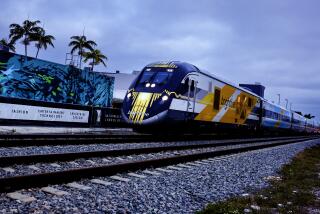Amtrak Tries to Improve Service and Cut Costs
WASHINGTON — When W. Graham Claytor Jr. became president of Amtrak, he quickly made known his dislike for the food on his trains. Budget cuts had forced freshly prepared entrees to give way to frozen dinners heated in a microwave oven.
Arguing that good food would attract passengers, Claytor promptly ordered that meals again be freshly prepared on board and even restored linen, china and silverware to some dining cars.
While not the most momentous decision by Claytor since he took over the nation’s passenger railroad in 1982, the new policy reflected Amtrak’s push in recent years to improve service, while at the same time facing pressure to hold down costs.
Attracted Headlines
Not many years ago Amtrak attracted headlines for running trains that were unsanitary, often had no heat and almost half the time didn’t arrive on schedule.
Much of that has changed. But the railroad, which was created as a private corporation by Congress and began operating in 1971 so the freight lines could bail out of the passenger business, is again fighting for survival--more so, some supporters say, than at any time in its history.
Amtrak has bought nearly 1,000 new cars over the past decade, replaced its old locomotives, purchased a computerized reservation system tied in with the airlines, built one of the industry’s most modern repair facilities and is about to finish a $2.1-billion track improvement project along the Northeast corridor.
It has improved its on-time record to better than 90% and has seen a sharp reduction in complaints.
The Reagan Administration announced in early February that it wants to eliminate federal subsidies for the railroad, a move that most railroad experts say would force it out of business.
Amtrak, which carries 20 million passengers a year between about 500 communities in 43 states, is getting $684 million from the government this year. It has asked Congress for a similar amount for the fiscal year beginning this October.
But says Transportation Secretary Elizabeth Dole: “At a time when deficit reduction is our highest national priority, we can no longer afford to provide railroad subsidies that primarily benefit passengers in the middle and upper income bracket.”
Widespread Skepticism
Even without federal money, some form of passenger rail service would be expected to survive with states or private investors likely to come up with the money, she said.
The suggestion was met with widespread skepticism in railroad circles. Rail experts noted the railroads already found once that they couldn’t make a profit hauling passengers. States also in the past flirted with trying to operate an intercity train and failed.
A few years ago, Delaware, Pennsylvania, Ohio and Indiana wanted to continue a train Amtrak had eliminated. But all four states wanted it to go through their state during the daytime and when that was found to be impossible the project fell apart.
More recently, Mississippi, Alabama and Louisiana couldn’t agree on continued support for the Gulf Coast Limited, a popular Amtrak train that linked Mobile and New Orleans last year. The train made its last run Jan. 6, 1985, after Mississippi decided against providing additional money.
Meanwhile, the debate over the future of Amtrak is about to unfold in Congress. In the past, Amtrak has shown itself to be one of Washington’s most durable survivors.
In 1979, the Carter Administration wanted Amtrak’s routes cut by 43%. After the dust settled, the rollback was limited to 16%.
Amtrak faced another challenge in 1981, when the Reagan Administration sought sharp cuts in its subsidies, saying the railroad should be limited to a few urban corridors such as the Boston-New York-Washington corridor. Congress disagreed and left the system intact.
More to Read
Sign up for Essential California
The most important California stories and recommendations in your inbox every morning.
You may occasionally receive promotional content from the Los Angeles Times.










